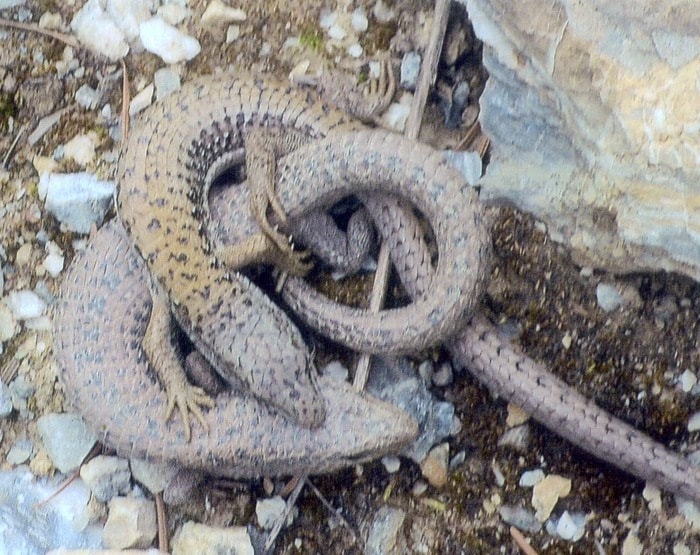Even in summertime, it’s too cool in our area, along the Kootenay River Valley, for rattlesnakes, but you will find two other reptiles here in the “persons” of the western skink and the northern alligator lizard. Skink sightings are rather infrequent; however, it is usually the young ones, with a brilliant blue tail, that get the attention.
Earthy coloured alligator lizards, in summer of course, are spotted most readily on pebbly, bare soil or on rocks where they warm up in the sun's rays, but they are also spotted in grass and near the base of clumps of shrubs on dry open slopes. They are frequently seen in sunny exposures along the Balancing Rock and the old Mount Thompson fire lookout trails and along forest service roads. If you have seen one with a short stubby tail rather than a long slender tail, chances are something or somebody has grabbed at it and only got the tail, as it breaks off quite easily when the lizard is being pursued. So the lizard starts out again on a tailless life, but only till it grows a new one, which, as it goes, is not as nice as the original piece of equipment.
Now, most lizards are tucked away for the winter in some deep rock crevice. Here they are protected against predators and winter frost.
The alligator lizard has a smoothly scaled body. They seem slippery in the hand, but unlike moist-skinned salamanders, which you may have thought were lizards, who nightly haunt damp wood, grass and aquatic communities, lizards are dry skinned and prefer dry hunting grounds. Caterpillars, worms, millipedes, flies and grasshoppers are a good dish any day. On hot days, they can move pretty fast, so the best time to spot and photograph them is when they are warming up in the morning sun. Like a butterfly will come to you when you are sitting quietly on a log, so lizards will come in full view, seemingly unaware that they have an audience.
They, with a keen sense of smell, sight and hearing and an ability to detect vibrations, are very equipped for detecting movement and changes in their surroundings. However, it is hard to detect alligator lizards, whose earthy colours and markings blend in with the surroundings.
I have had alligator lizards, when being held, try and bite my fingers. However, they couldn't because I held them firmly, like I would a snake, right behind the head. I don't think their bite is harmful except if they inflict a scratch and it gets a minor infection. In mating the male alligator lizard, to keep himself close to the female, holds the female “affectionately” in his jaws while sperm is being transferred. It may appear to some that they are fighting and one has “death” grip on the other. I don't know if they have, say, territorial confrontations like that or not. Next summer, you can check out the rest of the story from a quiet position, along one of our local trails, and by doing so, also step up the variety and quality in your life. Or, you can Google it. Let me know what you find.
Ed McMackin can be reached at 250-866-5747.
